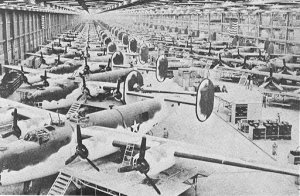![]() The Pacific War Online Encyclopedia
The Pacific War Online Encyclopedia
|
| Previous: Conscription | Table of Contents | Next: Convoys |

U.S. Air Force.
Via ibiblio.org
Consolidated Vultee Aircraft
Corporation was formed on 17 March 1943 as a merger of
Consolidated
Aircraft and Vultee Aircraft. Both companies had previously
operated
independently under the umbrella of AVCO.
Consolidated Aircraft dated back to 1923 and was
incorporated by Reuben Fleet, a former Army pilot
who had helped organize mail service. Fleet intended for the
company to specialize in Army trainer
aircraft, but the company found its true niche in flying boats, first with
the P2Y Ranger in 1933 and then with the PBY Catalina in 1933. The
firm moved to San Diego in
late 1935 to take advantage of the more
favorable climate. Approached in 1939 to become a second
manufacturer for the B-17
Flying Fortress, Consolidated instead developed the B-24
Liberator heavy
bomber,
which
was
arguably superior to the Flying Fortress. In 1941, Fleet sold his
interest in Consolidated to Vultee, though he remained active with
the
company until 1946.
Vultee Aircraft was founded as Airplane Development Corporation in 1932 by Gerard Vultee and Vince Breese. The company originally specialized in passenger aircraft, but changed hands several times before becoming Vultee Aircraft, Inc., in November 1939. Gerard Vultee, a capable aircraft designer, had been killed in a crash in Arizona in January 1938.
When Fleet sold his interests to AVCO in December 1941,
the head of AVCO, Victor Emanuel, "... was deeply worried, since
we knew nothing about big airplanes and the situation was a danger
to our country" (quoted by Klein 2013). Emanuel persuaded Tom
Girdler, CEO of Republic Steel, to become CEO of Consolidated and
Vultee as well. An opponent of both organized labor and the New
Deal, Gridler surprised everyone by cooperating with both to
improve output at the airplane factories. Girdler was unimpressed
with the romance of aircraft manufacture, regarding aircraft as
simply another article to be mass produced. Vultee had pioneered
the use of assembly lines in the aircraft manufacturing industry,
but now Girdler applied methods of mass production throughout the
Consolidated and Vultee plants.By March 1942 Consolidated was
running a 3000' (1000m) assembly line for the LIberators in three
eight-hour shifts six days a week. To man the assembly line,
Girdler added some 2500 women
to the work force.
In addition to the Liberator and Catalina, Consolidated
Vultee produced the Coronado
flying boats at its San
Diego plant. The company delivered more than 28,000 airframes
between December 1941 and August 1945. However, most of
the
production of the Liberator was
done by Ford at the Willow Run plant.
Consolidated Vultee in San Diego produced an average of about 40 PBY, 10 PB2Y, and 164 B-24 airframes a month. The company set up additional plants for B-24 production at Fort Worth, Nashville, New Orleans, and Wayne (MI), which produced an average total of about 114 airframes a month.
References
CentennialOfFlight.gov (accessed 2011-9-25)
The Pacific War Online Encyclopedia © 2007, 2011, 2013-2014, 2016 by Kent G. Budge. Index